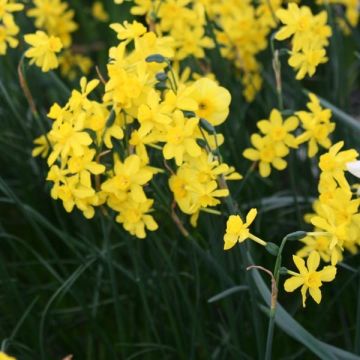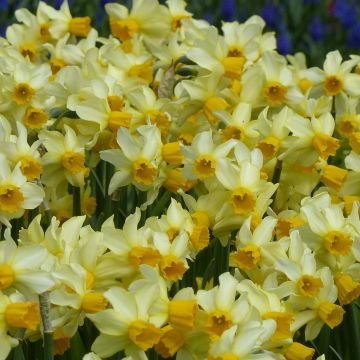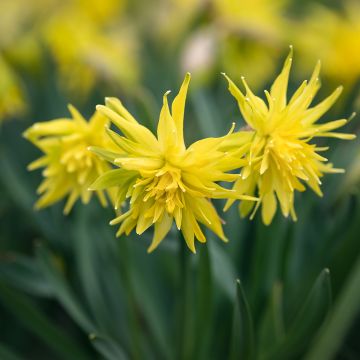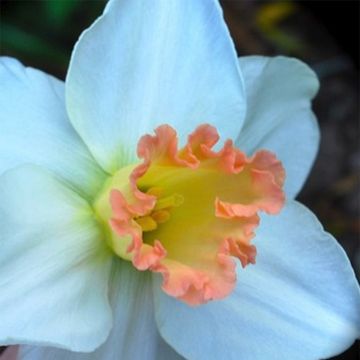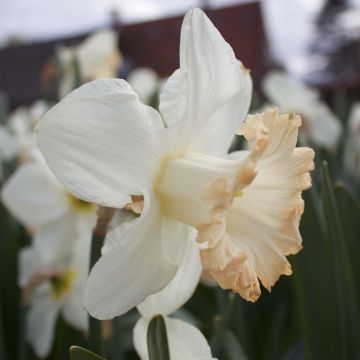Shipping country and language
Your country of residence may be:
Your country of residence is:
For a better user experience on our website, you can select:
Your shipping country:
Andorra
Austria
Belgium
Bulgaria
Canada
Chile
Croatia
Cyprus
Czechia
Denmark
Estonia
Finland
France
Germany
Greece
Hungary
Iceland
Ireland
Italy
Latvia
Lithuania
Luxembourg
Malta
Monaco
Netherlands
Poland
Portugal
Romania
Slovakia
Slovenia
Spain
Sweden
Switzerland
United Kingdom
We only deliver seed and bulb products to your country. If you add other products to your basket, they cannot be shipped.
Language:
French
German
Spanish
English
My Account
Hello
My wish lists
Plantfit
Log in / Register
Existing customer?
New customer?
Create an account to track your orders, access our customer service and, if you wish, make the most of our upcoming offers.
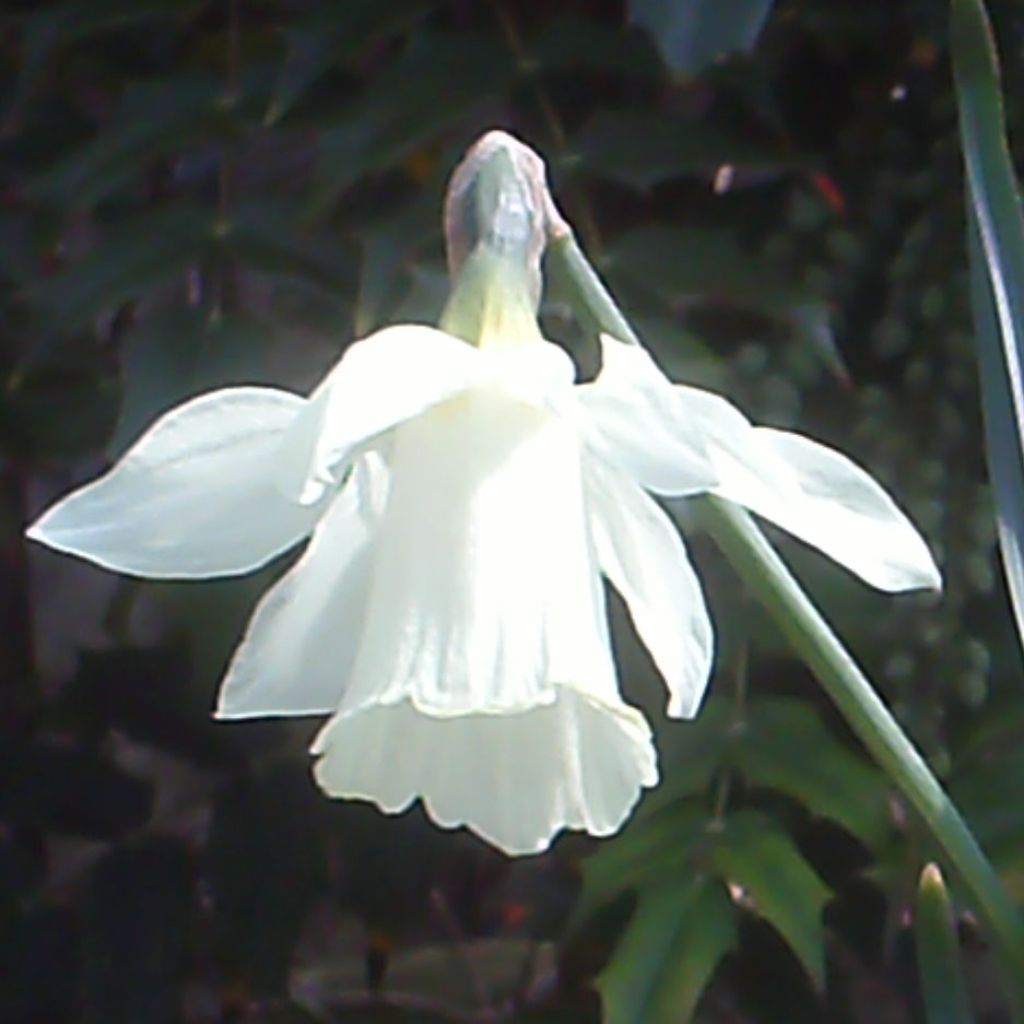

Narcissus moschatus
Narcissus moschatus
Narcissus pseudonarcissus moschatus
Wild Daffodil, Lent Lily, swan's neck daffodil
Small disappointment as the colour is not the pure white expected.
Tessa V., 26/04/2017
Order in the next for dispatch today!
Dispatch by letter from €3.90.
Delivery charge from €5.90 Oversize package delivery charge from €6.90.
More information
This item is not available in your country.
Schedule delivery date,
and select date in basket
This plant carries a 6 months recovery warranty
More information
We guarantee the quality of our plants for a full growing cycle, and will replace at our expense any plant that fails to recover under normal climatic and planting conditions.
From €5.90 for pickup delivery and €6.90 for home delivery
Express home delivery from €8.90.

Does this plant fit my garden?
Set up your Plantfit profile →
Description
Narcissus moschatus is a botanical species that produces pendulous, white flowers. It will reach a height of approximately 15 to 20 cm (6 to 8in). Narcissus are easy-to-grow and hardy bulbous plants that can be easily grown in the garden. Bulbs should be planted in autumn for flowering in April.
Native to Western Europe, daffodils belong to the Amaryllidaceae family. The narcissus genus includes numerous species and varieties, both of botanical origin (such as the Musk Narcissus) and horticultural. The daffodil (Narcissus jonquilla), with its yellow flowers and reed-like leaves, is one of the species in the Narcissus genus. In some regions, the yellow narcissus or trumpet narcissus (Narcissus pseudonarcissus) is sometimes called daffodil, leading to frequent confusion between daffodil and narcissus.
This Narcissus produces flowers with white petals, with a flared tube in the centre, also white. Its flowers are pendulous.
Narcissus flower for about fifteen days between February and May, depending on the varieties (April for this variety). These flowers are perfect for cut flowers, as long as they are not mixed with other flowers because the sap releases a substance that accelerates wilting.
Narcissus are easy to grow in various locations in the garden: in the foreground of a shrub bed, along borders, in the middle of a lawn or in pots. It pairs well with grape hyacinths, early tulips, and hyacinths, and naturalises easily. Be careful as the bulb, flower, and leaves are toxic. This deciduous bulbous plant is hardy and perennial, and bulbs can remain in the ground for several years.
Narcissus moschatus in pictures


Plant habit
Flowering
Foliage
Botanical data
Narcissus
pseudonarcissus
moschatus
Amaryllidaceae
Wild Daffodil, Lent Lily, swan's neck daffodil
Western Europe
Other Botanical Daffodils
Planting and care
Daffodils are undemanding in terms of soil type and thrive in any ordinary, preferably moist and fertile soils, in a sunny or semi-shaded location. In order to spread out the flowering, place them in several locations, varying in sunlight, as daffodils bloom depending on the amount of sunlight.
Plant the bulbs from September to November for spring flowering, 15 cm (6in) deep, with the pointed end facing upwards, and 8 cm (3in) apart. You can plant them in groups of 5 to 10 bulbs to achieve a beautiful colour effect in spring.
Daffodils require little maintenance, simply remove faded flowers to avoid depleting the bulb. After flowering, let the foliage naturally wither and only cut it when it turns yellow to promote the accumulation of new reserves in the bulb.
Daffodils can remain in place from one year to the next. If the clumps become dense and flower less, carefully remove the bulbs when the foliage is dry and divide them before immediately replanting.
Planting period
Intended location
Care
- , onOrder confirmed
Reply from on Promesse de fleurs
Narcissi - Daffodils
Haven't found what you were looking for?
Hardiness is the lowest winter temperature a plant can endure without suffering serious damage or even dying. However, hardiness is affected by location (a sheltered area, such as a patio), protection (winter cover) and soil type (hardiness is improved by well-drained soil).

Photo Sharing Terms & Conditions
In order to encourage gardeners to interact and share their experiences, Promesse de fleurs offers various media enabling content to be uploaded onto its Site - in particular via the ‘Photo sharing’ module.
The User agrees to refrain from:
- Posting any content that is illegal, prejudicial, insulting, racist, inciteful to hatred, revisionist, contrary to public decency, that infringes on privacy or on the privacy rights of third parties, in particular the publicity rights of persons and goods, intellectual property rights, or the right to privacy.
- Submitting content on behalf of a third party;
- Impersonate the identity of a third party and/or publish any personal information about a third party;
In general, the User undertakes to refrain from any unethical behaviour.
All Content (in particular text, comments, files, images, photos, videos, creative works, etc.), which may be subject to property or intellectual property rights, image or other private rights, shall remain the property of the User, subject to the limited rights granted by the terms of the licence granted by Promesse de fleurs as stated below. Users are at liberty to publish or not to publish such Content on the Site, notably via the ‘Photo Sharing’ facility, and accept that this Content shall be made public and freely accessible, notably on the Internet.
Users further acknowledge, undertake to have ,and guarantee that they hold all necessary rights and permissions to publish such material on the Site, in particular with regard to the legislation in force pertaining to any privacy, property, intellectual property, image, or contractual rights, or rights of any other nature. By publishing such Content on the Site, Users acknowledge accepting full liability as publishers of the Content within the meaning of the law, and grant Promesse de fleurs, free of charge, an inclusive, worldwide licence for the said Content for the entire duration of its publication, including all reproduction, representation, up/downloading, displaying, performing, transmission, and storage rights.
Users also grant permission for their name to be linked to the Content and accept that this link may not always be made available.
By engaging in posting material, Users consent to their Content becoming automatically accessible on the Internet, in particular on other sites and/or blogs and/or web pages of the Promesse de fleurs site, including in particular social pages and the Promesse de fleurs catalogue.
Users may secure the removal of entrusted content free of charge by issuing a simple request via our contact form.
The flowering period indicated on our website applies to countries and regions located in USDA zone 8 (France, the United Kingdom, Ireland, the Netherlands, etc.)
It will vary according to where you live:
- In zones 9 to 10 (Italy, Spain, Greece, etc.), flowering will occur about 2 to 4 weeks earlier.
- In zones 6 to 7 (Germany, Poland, Slovenia, and lower mountainous regions), flowering will be delayed by 2 to 3 weeks.
- In zone 5 (Central Europe, Scandinavia), blooming will be delayed by 3 to 5 weeks.
In temperate climates, pruning of spring-flowering shrubs (forsythia, spireas, etc.) should be done just after flowering.
Pruning of summer-flowering shrubs (Indian Lilac, Perovskia, etc.) can be done in winter or spring.
In cold regions as well as with frost-sensitive plants, avoid pruning too early when severe frosts may still occur.
The planting period indicated on our website applies to countries and regions located in USDA zone 8 (France, United Kingdom, Ireland, Netherlands).
It will vary according to where you live:
- In Mediterranean zones (Marseille, Madrid, Milan, etc.), autumn and winter are the best planting periods.
- In continental zones (Strasbourg, Munich, Vienna, etc.), delay planting by 2 to 3 weeks in spring and bring it forward by 2 to 4 weeks in autumn.
- In mountainous regions (the Alps, Pyrenees, Carpathians, etc.), it is best to plant in late spring (May-June) or late summer (August-September).
The harvesting period indicated on our website applies to countries and regions in USDA zone 8 (France, England, Ireland, the Netherlands).
In colder areas (Scandinavia, Poland, Austria...) fruit and vegetable harvests are likely to be delayed by 3-4 weeks.
In warmer areas (Italy, Spain, Greece, etc.), harvesting will probably take place earlier, depending on weather conditions.
The sowing periods indicated on our website apply to countries and regions within USDA Zone 8 (France, UK, Ireland, Netherlands).
In colder areas (Scandinavia, Poland, Austria...), delay any outdoor sowing by 3-4 weeks, or sow under glass.
In warmer climes (Italy, Spain, Greece, etc.), bring outdoor sowing forward by a few weeks.




